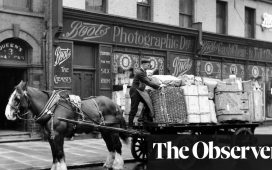When silversmith Colin Morrison-Ignatieff stood with six other craftsmen to present the new Elizabeth Sword to King Charles III in July, it brought full-circle a story which began over two centuries before in his Glasgow workshop.
Morrison-Ignatieff — who gilded the sword’s thistle-design hilt and grip, as well as its pommel cap and scabbard mounts — has a 200-year-old wooden box in his workshop, three floors above Glasgow’s Argyll Arcade. Inside it are the tools last used in 1818 to repair the Crown of Scotland, after it had lain walled off in Edinburgh Castle for more than 100 years.
Now, the Elizabeth sword, named after the late queen, has become the first new item to be added to the Honours of Scotland — the country’s Crown Jewels — in five centuries.
“That is the history of this country,” says Ignatieff of the stories chiselled in the swords, trophies and trinkets he repairs. “You’ve had those skills passed down to you. When we get Victorian and Georgian pieces in, we know exactly how they were put together.”


For close to 150 years, this desire to build upon past traditions has drawn jewellers and watch sellers to the grade-A listed Argyll Arcade, the UK’s only remaining arcade dedicated solely to watches and jewellery. Constructed in 1827 in an L-shape, connecting the city centre thoroughfares of Buchanan Street and Argyle Street, its hammerbeam roof is more reminiscent of a baronial castle than a shopping mall.
“It’s about generations and families,” says Norman Crabb, who patrols the arcade and greets the newly betrothed, for whom a visit there is a rite of passage on their journey down the aisle. “You rarely see an empty unit here; a shop might be empty for a week and then it’s filled.” Crabb knows what he is talking about: his father and two uncles all maintained shop units there.
The arcade was inspired by the glass-covered Parisian arcades of the same era; the association with watches and jewellery dates from 1887, when James Porter, a clockmaker’s apprentice, chose to open a store there to service the watch trade. Today, James Porter & Son continues to trade there and ranks as Scotland’s fifth oldest business, having been passed down from father to son for five generations.
Yet for Simon Porter — great-great-grandson of James Porter and company director since taking over from his father in 2007 — the constant competition posed by the dense concentration of more than 30 jewellers and watch retailers leaves no room for complacency. “As an independent, we have to constantly adapt and change our game,” he says.
Having been one of the first UK stockists for watch brands such as Japan’s Grand Seiko and French label Michel Herbelin, Porter opened a multi-brand watch store last year — the company’s third in the arcade.
Today, the family tradition continues: Porter’s wife, Rachel, joined the business this year and their son and daughter contribute to its social media feeds. “I love what I do and I’m very fortunate to have the business . . . but you have to be very passionate about it,” he says.


While Porter has expanded within the arcade, others are trying to land their first retail unit. When one such unit became available in 1993, jeweller Grant Mitchell leapt at the chance to move his fledgling jewellery stall in London’s Camden Market to a 150 sq ft unit in the covered walkway.
“They were like gold dust,” says Kyron Keogh, who in 2002 co-founded the jeweller Rox with Mitchell in the arcade and is, today, the head of the Glasgow City Centre Retail Association. “[Shop units] never came up in the Argyll Arcade. When we started Rox, 20 years ago, the market was pretty polarised,” Keogh recalls.
At the time, research indicated that, because of the concentration of jewellers with similar offerings, some buyers would leave the arcade not knowing which shop they had just purchased an engagement ring from. Keogh and Mitchell brought in their Thrill Room concept in 2011, greeting customers with a glass of champagne in a mirror-covered room furnished with velvet armchairs.
“We were inspired by the continental model of much more accessible spaces and energy,” says Keogh. “We felt, by making this statement with the Thrill Room, we really wanted to stand out.”
For Mitchell and Keogh — and for other local jewellers — the arcade acted as a training ground for expansion into the national market. Since opening there, Rox now has three stores in Glasgow and five others across the UK. “It’s probably one of the most competitive places to trade . . . almost every single watch brand is represented in there,” says Keogh. “If you can trade successfully in the Argyll Arcade, you should be able to trade successfully anywhere.”
Across the light-strewn walkway, Chisholm Hunter, which was founded in Glasgow in 1857, now has three stores in the arcade alone and a further 25 across the UK. For retail director Max Brown, son of owner Harry Brown, the high-stakes customer focus essential for any retailer to survive in the Argyll Arcade was instrumental in the company’s expansion into the national market — where, in 2022, it saw an 87 per cent rise in sales, from £29mn to £54mn.
“Outside of perhaps [London’s] Hatton Garden, there is arguably no other jewellery retail space with such a concentrated level of competition,” says Brown. “If we don’t delight our client with our level of care, there will be another team in the arcade that certainly will.”


Rox’s Thrill Room concept has since been rolled out to the chain’s five other stores, including its recently opened boutique in London’s redeveloped Battersea Power Station. In 2021, Kering-owned brand Gucci partnered with Rox when it chose the Argyll Arcade for its first standalone UK store dedicated entirely to its watch and jewellery collections, showcasing the house’s newest lines, including the Gucci 25H, G-Timeless and Link to Love.
The draw of the arcade for brands such as Gucci is also being felt in neighbouring Buchanan Street — the busiest thoroughfare for footfall in the UK after London’s Oxford Street — where Watches of Switzerland runs mono-branded stores for Rolex, Omega, Tudor, Breitling and Longines.
The company’s investment in the city has personal significance for chief executive Brian Duffy, who grew up in Glasgow’s Castlemilk district and purchased his wife’s engagement ring in Argyll Arcade more than 40 years ago. “It’s a great place for us to invest,” he says. “There’s a great appreciation for fine watches in Glasgow. As a young man I’d look in the windows of Mappin & Webb and wonder how anyone could ever afford what’s there.” Next month, Watches of Switzerland will unveil a renovation of the Mappin & Webb store on the corner of Buchanan Street and the arcade.
For Duffy, this prized location speaks to the two thoroughfares’ symbiotic relationship. “There’s a natural reason to want the passing traffic of Buchanan Street,” he says, noting that watches and jewellery are items shoppers mostly buy in person. “Any development on one part of it is going to benefit the whole configuration.”
In September, the sixth-generation family jeweller Laings — founded in Glasgow in 1840 and based in the arcade for more than 50 years — opened its first standalone Tag Heuer boutique on Buchanan Street, with another to follow in Edinburgh next spring.
For Joe Walsh, Laings chief executive and husband of sixth-generation Laings owner Wendy Walsh, the choice of the street — which claims the highest rent of any in the UK outside London at £280 per square foot — is in part driven by a shrinking, post-pandemic retail landscape in which luxury brands increasingly desire to be on the highest-profile retail thoroughfares.


“There’s a shift across all the high streets, particularly in the watch and jewellery market,” he says. “Swiss watch brands are coming out of the multi-brand environment and opening their own dedicated boutiques.” Another contributing factor is the growth of social media, where luxury watch brands have become household names to an increasingly young demographic. “What everyone wants has become quite defined now; and it’s a brand.”
Having called the arcade home since 1971, next spring Laings will move to a new £5mn boutique and headquarters in Buchanan Street’s Art Deco Rowan House, of which £1.2mn has been invested in the largest watch repair workshop owned by an independent jeweller in the UK.
The expansion at the city’s oldest continuously run company, which also has stores in Edinburgh, Cardiff and Southampton, comes after Swiss watch exports to the UK rose by 21.5 per cent in 2022. “As watch sales have grown steadily over the years, the servicing grows exponentially behind that, as all the watches stay in the market,” says Walsh. “Because of that growth, we need to build watch facilities.”
The watch repair workshop, where prices start at £75 for simple maintenance and £200 for a complete service depending on complications, will employ 11 staff in total, with new recruits from the British School of Watchmaking working alongside colleagues who have worked at Laings for 30 years.
“The romance of watchmaking, that’s what appeals to watchmakers,” says Serena Gough, head of service at Laings and a graduate of the British School of Watchmaking herself. “It’s great to offer new career opportunities that aren’t locally available and see a skill thrive in an area it hasn’t before.”
But, while the Argyll Arcade and Buchanan Street have thrived on an influx of investment from independent jewellers and Swiss watch retailers, the rest of the city’s retail offering has suffered disproportionately since Covid, with city centre footfall remaining at 79 per cent of pre-pandemic levels. Though Glasgow has maintained its decades-held position as the top centre for retail spending in the UK outside London, its relatively small city centre population compared with other big cities has left its retail economy particularly exposed by the shift to hybrid working.
As part of an effort to double the city centre population to 40,000, two of the city’s largest shopping malls, St Enoch Centre and Buchanan Galleries, are set for demolition in the coming years. “The whole repurposing of Glasgow City Centre is under way,” says Stuart Patrick, chief executive of the Glasgow Chamber of Commerce. In August, the Chamber released a report proposing plans to diversify Argyle Street, Buchanan Street and Sauchiehall Street, the city’s so-called Golden Z of retail, with increased housing, urban parks and cultural hubs.


But, for Patrick, the strength of any city’s retail offering depends on independent retailers coexisting with large chain stores. “There is a lot of investment going into jewellery and watches on Buchanan Street, but we want to make sure that we maintain a full mix,” he says. “It was a good thing that the independents have held on to the jewellery trade. That gives us the opportunity to have some very distinctive investments happening.”
Back in Argyll Arcade, Simon Porter is proud to have opened an independent, multi-brand watch boutique in such a competitive market. For Joe Walsh, who is determined to ensure the arcade units that Laings will vacate in 2024 remain in the hands of neighbouring jewellers, the shrinking bricks-and-mortar retail landscape brings new opportunities for the arcade. “I do believe in the future of the arcade,” he says. “Whether these are all jewellers in 10 years’ time, I don’t know. But, if not, it could include very high-end clothes boutiques.”
For Kyron Keogh, whatever change happens, the arcade’s legacy ensures its future is secure. “It would be interesting to see if the arcade over the next 20 to 30 years could maybe change a little bit,” he says. “The Argyll Arcade has been here for 196 years and it will be here for another 196 years.”










